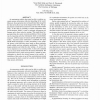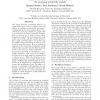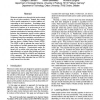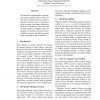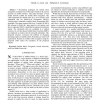MVA
1990
14 years 20 days ago
1990
An autonomous mobile robot must be able to combine uncertain sensory information with prior knowledge of the world. Moreover, these operations have to be performed fast enough for...
IJCAI
1993
14 years 25 days ago
1993
This paper describes a technique whereby an autonomous agent such as a mobile robot can explore an unknown environment and make a topologicalmapofit. It is assumedthat the environ...
IJCAI
1997
14 years 25 days ago
1997
Localization is the problem of determining the position of a mobile robot from sensor data. Most existing localization approaches are passive, i.e., they do not exploit the opport...
BMVC
1998
14 years 26 days ago
1998
We address the problem of detecting and tracking people with a mobile robot. The need for following a person with a mobile robot arises in many different service robotic applicati...
AAAI
1998
14 years 26 days ago
1998
For mobile robots to be successful, they have to navigate safely in populated and dynamic environments. While recent research has led to a variety of localization methods that can...
IJCAI
2003
14 years 26 days ago
2003
In this paper we introduce coverage maps as a new way of representing the environment of a mobile robot. Coverage maps store for each cell of a given grid a posterior about the am...
IJCAI
2003
14 years 26 days ago
2003
Whenever people move through their environments they do not move randomly. Instead, they usually follow specific trajectories or motion patterns corresponding to their intentions....
EACL
2003
ACL Anthology
14 years 26 days ago
2003
ACL Anthology
We describe an implementation integrating a spoken dialogue system with a mobile robot, which the user can direct to specific locations, ask for information about its status, and...
IJIT
2004
14 years 27 days ago
2004
Developing techniques for mobile robot navigation constitutes one of the major trends in the current research on mobile robotics. This paper develops a local model network (LMN) fo...
LANMR
2007
14 years 28 days ago
2007
This paper presents a system that controls the behavior of a mobile robot. The system is based on situation calculus, the initial state is described and a goal is given, Prolog pro...
